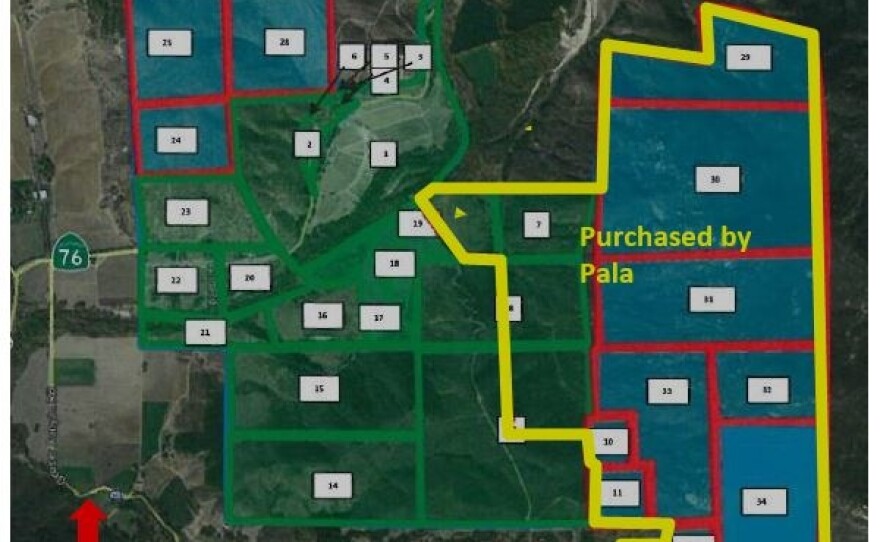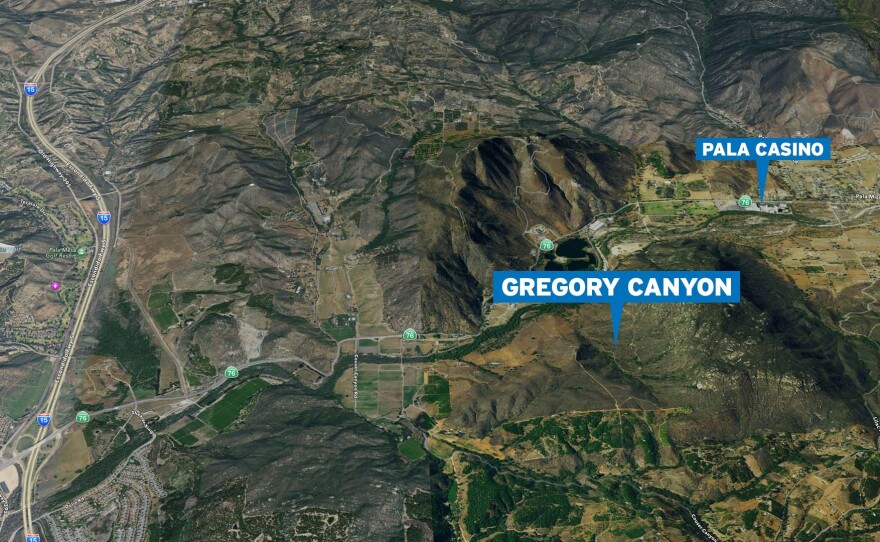An old San Diego controversy comes when and with the sale of the Gregory Canyon landfill an update on the Trump University lawsuit coming up on KPBS Roundtable . This is KPBS Midday Edition. I'm Marine Cavanaugh. Our top story a midday edition whether the longest running land-use controversies in San Diego County is over. The mission Indians have announced the purchase of land proposed for the Gregory Canyon landfill. That means the plan 25 years in the making to build a landfill in a rule area will not happen. Joining me is Alison St John para no welcome. Glad to be here. This seem to take most people by surprise. Up until this announcement it looked at the landfill plan was still moving forward? Yes, it did there were big fences coming up around the property last year of a new investment company we knew that the original company that attracted a lot of investors was having problems but once that got voted out last year it got like the new company was going to pick up the threads and get the permits. Tell us the specifics of this deal. How much did the Indians pay? The whole property is about 1700 or more acres so that investment company will still have about 1000 acres left to work with. Essentially the deal is that they paid the $13 million and then it agrees not to oppose what the developer does with the rest of the land, which is a little bit for the rest desert West. The lentil proposal has had a long tortured history in San Diego. Can you fill in some of the highlights. It was back in 1990 for that they first voted for proposition that was to turn it into a landfill for the county. 10 years later it still had in happen and it was put back to the boaters and taken out of the hands of the county supervisors. The voters inking it his way up there and we need more landfill space so they voted for it again. Partly because there are some pretty big questions around it. It had a great deal of trouble getting its permits. We knew that the company was taking a very long time to get the permits. In the meantime investors were getting impatient so in the end, they had to foreclose on it just in the last couple of years and a whole new set of investors bought the property at pennies on the dollar and started without the weight of the old investment behind the. That is why they were able to go in a new direction. So you say there were a lot of problems getting permits for this proposal. Is out why environmentalists were opposed to this landfill? Yes, the San Luis Rey River runs right through this canyon and along 76 and out to see. So the Pala Band uses groundwater and a lot of places are connected to the aquifer . Even the city of Oceanside has invested a lot of money in cycling groundwater, which could've been threatened. We are not talking about a few years or 10 years, but 100 years in the future eventually there was a fear that the landfill would leak and affect the whole aquifer. The Pala Band had a spiritual objection. Tell us about that . That is true. That is really why they put the $13 million into buying the site of Gregory Mountain. They feel like this has spiritual significance and Shasta was implied as their environmental director and really has been working very hard. She put it this way she said it's not common that the tribe talks about their heritage but in this case, they had to. We've always been pretty open about why the mountain is sacred. It is a restingplace of an important spirits in the tribes -- we had to make that public for people to understand why it's so important. This is part of the spiritual and cultural tradition for all of the people for the tour we a people. They are related and they share a lot of the same origins and spiritual practices. It was important to -- Now that that Gregory Canyon landfill would not be built at their, the company still wants to put up some housing and commercial development in the area. Are there any potential problems with that? They will have to change the zoning. The zoning is for a landfill. So rather than going through sequence they would like to put it on the ballot so we should have another boat very similar to the vote that we just seen recently. The developer and that investment company believes this is a different situation and it may prove that there are some pretty significant factors that are different in the sense 76 is a major thoroughfare and 76 and 15 is already attracting a lot of new development. Palomar College has more buildings and there's a lot of housing going up there. Caltrans has committed to making improvements to the road. So this could be something that will be seen coming up on the ballot in 2010.
More than 20 years of controversy over a plan to put a landfill in Gregory Canyon in North County comes to an end, as the Pala Band of Mission Indians buys a portion of the site for $13 million.
San Diego voters have twice approved a plan to develop a landfill in Gregory Canyon — the first time back in 1994, then again in 2004. But for more than 20 years the project — off state Route 76, three miles east of Interstate 15 — was vigorously opposed.
Opponents argued the San Luis Rey River that runs beneath the site would eventually get polluted. Jurisdictions as far away as Oceanside use the groundwater that connects to the aquifer. The Pala Band of Mission Indians has a casino nearby, and the band relies on groundwater.
Robert Smith, chairman of the Pala Band, said its members voted this week to go ahead with the $13 million purchase of 700 acres on Gregory Mountain, in order to stop the dump.
“Yeah, we’ve been fighting it for over 20 years,” Smith said. “The main thing is protecting our water sources and ancestral burial grounds and village, so it’s a great accomplishment for the tribe.”
Shasta Gaughen, the environmental director and Tribal Historic Preservation Officer for Pala, said several Native American Indian bands regard Gregory Mountain as sacred, the legendary home of one of their spirit ancestors.
“We had to make that public for people to understand why it was so important that trash not to be piled on the side of Chok’la on Tauquitch’s home," Gaughen said. “This is part of the spiritual and cultural tradition for all of the Luiseno people, for the Cupeno people, even for Cahuilla people. All those bands are related and they share a lot of the same origins and spiritual practices, so it was important to pretty much the entirety of Southern California.”

The original investors in Gregory Canyon had such trouble getting the permits for the landfill they were eventually foreclosed. A San Diego investment company, Sovereign Capital, bought the land last year for pennies on the dollar.
Todd Mikles of Sovereign Capital called the effort to build the landfill “a black hole” for previous investors.
“I think it’s over $100 million,” he said. “Definitely well over $100 million. The list of investors was quite long.”
In working with the Army Corps of Engineers in Washington on a long awaited permit for the project, Mikles learned about the 106 Review Process, which requires the Corps of Engineers to consult with tribes to weigh the cultural value of sites.
Mikles returned to the Pala Band to negotiate. The agreement they have reached allows the band to take possession of Gregory Mountain and allows Sovereign Capital to pursue a commercial and residential development on the remaining land, a little more than 1,000 acres.
"I think that’s where we decided we could do something different,” Mikles said. "And the tribe would support it because they feel the valley is ripe for development and they feel that would help them as well, so it was a win-win for both parties.”

Mikles said his goal is to put an initiative on the ballot in 2018 to rezone the land. County spokesman Gig Conaughton said the land is currently zoned for a solid waste facility. It’s a unique zoning created in 1994 when the voters adopted Proposition C, establishing the site as a landfill site.
Gregory Canyon is just a few miles north of Lilac Hills where Accretive Investments failed to win — in spite of investing $5 million — voter approval for Measure B, an initiative on the November Ballot earlier this month that would have allowed a housing development in Valley Center.
“I think we’re different,“ Mikles said. “Lilac Hills was different because they didn’t have the infrastructure of roads. But at the entry of 76 and 15 there’s a lot of development with Palomar College and a lot of homes being developed there. A lot of infrastructure is being planned though Caltrans.”
Perhaps the biggest difference is that, unlike Lilac Hills, where the neighbors worked hard to keep the property rural, part of Sovereign Capital’s agreement with Pala is that the band will not oppose the project.







